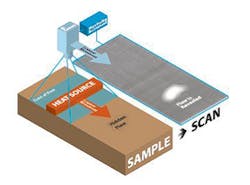Thermography system inspects composites during production
Engineers at the Mistras Group (Princeton Junction, NJ, USA) are determining the feasibility of using Line Scanning Thermography (LST) for the non-destructive inspection of pultruded composite structures during manufacturing.
Pultrusion is a continuous process for manufacture of composite materials with constant cross-section. In the process, reinforced fibers are pulled through a resin and into a heated die, where the resin undergoes polymerization.
To investigate whether the presence of defects could be detected in the composite during the manufacturing process, the Mistras engineers coupled a heat source with an InSb MWIR camera that moved in tandem across the surface of a sample of material.
As the heat source was moved across the sample's surface at a constant speed, the IR imager recorded the temperature changes in the surface during the heating process.
The thermal images generated using the LST technique provided information about regions in the material affected by delamination, voids or cavities in the matrix, or a change in the composition of the composite.
Having completed their tests, the researchers believe that the LST technique could be used for the on-line, rather than off-line, inspection of pultruded panels. Further work is underway to examine the feasibility of doing so in a production environment.
More information can be found in the presentation "Line Scanning Thermography for the Non-Destructive Inspection of Pultruded Composite Structures" by the Mistras Group's Obdulia Leya and colleagues. It is available here.
Recent articles on IR cameras from Vision Systems Design that you might also find of interest.
1. Inexpensive IR lenses could reduce camera costs
Researchers at the Fraunhofer Institute for Mechanics of Materials have developed a method to dramatically lower the production cost of the infrared (IR) lenses used in thermal cameras.
2. IR cameras take aim at machine-vision applications
System integrators must weigh the benefits of numerous detector technologies and spectral response characteristics before choosing an infrared camera for industrial inspection applications.
3. 'Super-framing' increases the dynamic range of thermal imagers
Dr. Austin Richards and his colleagues at FLIR Systems (Wilsonville, OR, USA) have applied a 'Super-framing' technique to the company's SC6000 and SC8000 series of InSb-based infrared (IR) cameras to extend the effective scene brightness of a thermal image while maintaining its thermal contrast.
Vision Systems Design magazine and e-newsletter subscriptions are free to qualified professionals. To subscribe, please complete the form here.
-- Dave Wilson, Senior Editor, Vision Systems Design
